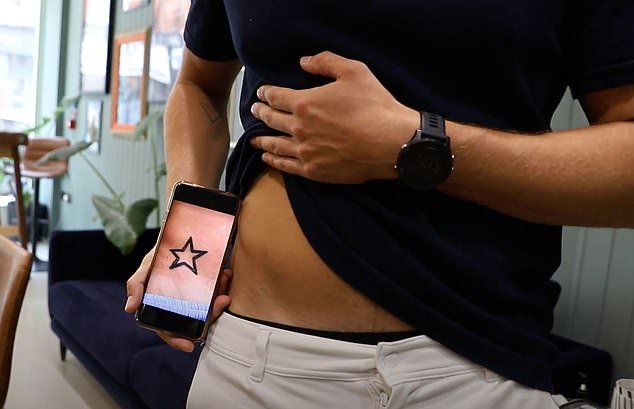A state-of-the-art laser gun that shoots the skin trillions of times per second can completely remove tattoos – but causes little pain and leaves no scarring.
The LightSense system, the first innovation in tattoo removal in a decade, has proven to be highly effective in clinical trials and works well even on black and brown skin – something that was previously difficult, if not impossible.
Tattoos are created by using a needle to punch ink into the dermis – the middle layer of the skin. Due to the large size of the ink particles, the immune system is unable to break them down. Therefore, cells called microphages surround the ink and stay in place, naturalizing it. This causes the tattoo design to get stuck in the dermis.
Older methods of laser removal, while effective, were often tiring and sometimes left skin with inflammation, blisters, sores and bruises for weeks. Repeated sessions could also leave a combination of residual ink and pale scars – sometimes known as a ghost tattoo.

Jack Revell, a London-based model and fitness trainer, regretted his first tattoo, which he got at the age of 16

One patient who has benefited from LightSense is model and fitness trainer Jack Revell
The most advanced method of tattoo removal to date has been to use a picosecond, or pico, laser, which emits up to a trillion pulses per second. The pulses break up the ink particles and help the body absorb them, causing them to disappear.
But LightSense is a form of a femtosecond laser – meaning it can emit a quadrillion (one thousand trillion or 1,000,000,000,000,000) pulses per second.
New Jersey-based dermatologist Dr. Steven Hubert, who was part of the team that developed the LightSense laser at Princeton University, said: “Pico lasers were a big improvement over older methods of tattoo removal, but they were not as effective or painless as everyone had it hoped.
“Our laser has a shorter (faster) pulse duration, so less energy is needed to deliver the shocks to the tattoo ink. This means less injury to the surrounding tissue.”
LightSense is currently only available at one clinic, NAAMA in central London, where more than 18,000 treatments have been carried out in the last two years.
In clinical studies, patients with skin types ranging from pale and white to dark brown found that their tattoo disappeared by at least 50 percent after three sessions. On lighter skin tones, the laser was effective on the back as well as on purple, red, yellow and orange inks. For darker skin, only the black ink was clearly cleared.
Colored inks have always been more difficult to remove because they reflect laser light, making them harder to dissolve.
Research also shows that post-treatment reactions such as inflammation and redness, blistering and itching are rare, affecting fewer than one in ten patients.
According to a YouGov survey, one in three working-age Brits has a tattoo – including one in nine with a visible tattoo on their face, neck, forearms, wrists or hands.
Two-thirds of people regret at least one of their tattoos – with a person’s name being the main reason. According to Statista, about one in ten people have requested removal, and another 30 percent have thought about it.
LightSense costs from £140 per session for a small tattoo under two square inches and between £200 and £340 per session for larger designs. Black tattoos typically require ten sessions.
One patient who has benefited from LightSense is model and fitness trainer Jack Revell.
The 34-year-old from London got his first tattoo, a star on his right hip, at the age of 16 – a decision he later regretted.
“It took about 20 minutes to get the tattoo and at first I thought it would be cool to be a bit rebellious,” says Jack. “But that wore off when I was in my early 20s and I realized it was a stupid mistake.”
Jack, who began modeling at the age of 18, found the tattoo was affecting his career.
“It was just above the pant line, which meant it was visible when I took off my top,” he says. “Back then, tattoos in modeling weren’t as accepted as they are today, and in some jobs the casting call was ‘no tattoos’.”
In 2015, he decided to try laser removal – with little success. “It was so painful,” Jack says. “Like someone stabbing you over and over again with a lit cigarette.” It left blisters that took weeks to heal and looked worse than before as they faded somewhat, but not completely. I thought I had to learn to live with it.”
In 2020, his then-girlfriend mentioned that she had signed up to take part in a clinical trial for a new laser for tattoo removal. “She had a tattoo on her finger that she hated,” Jack says. “I signed up for the trial too.”
Jack had his first of 24 sessions in May this year.
He adds: “They applied an anesthetic cream and I could barely feel the laser.” It was like a small electric shock. Then add some cream and a clear dressing on top. There was no blistering or pain and I was able to carry on with my life as normal.
“I had sessions every two weeks for about six months, then every three until the tattoo completely faded. I was skeptical at first, but it’s really gone.
“I’ve had a few other tattoos since the first one, but I don’t hate any of them so much that I would have them removed.” “It’s good to know it’s an option, though.”
